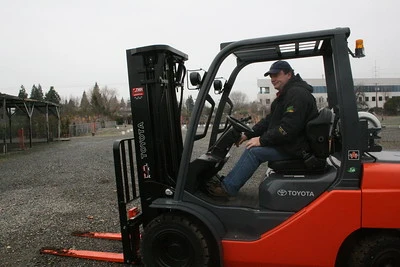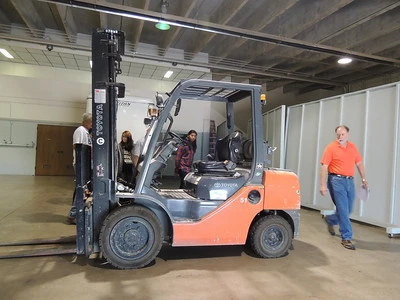How High The Forks Should Be When Driving Forklift
May 15, 2024 | by onlineoshasafetytraining.com


When driving a forklift, the general guideline is to keep the forks about 4-6 inches off the ground. This height is ideal for a few reasons:
- Better Visibility: Keeping the forks low helps you see where you’re going. If the forks are too high, they can block your view and make it harder to spot obstacles.
- Stability: When the forks are low, the forklift is more stable. High forks can make the forklift top-heavy and more likely to tip over, especially when turning.
- Safety: Low forks reduce the risk of accidentally hitting things around you, like shelves, walls, or other people. It also helps prevent damaging the load you are carrying.
However, some people suggest keeping the forks a bit higher, around 6-10 inches off the ground. This can help avoid potential hazards on the ground, like small debris or uneven surfaces. The key is to find a balance that ensures both safety and smooth operation.
By keeping the forks at the right height, you make sure you’re driving safely and efficiently.
What Are These Potential Hazards
- Small Debris
- Why it should be avoided: Small debris can cause sudden jolts or shifts in the forklift’s movement. If the forks are elevated, the forklift’s center of gravity is higher, making it more prone to tipping over when it hits debris. This can lead to loss of control and potential accidents.
- Uneven Surfaces
- Why it should be avoided: Driving over cracks, potholes, or uneven pavement can destabilize the forklift. Elevated forks increase the risk of tipping because the load is higher, making the forklift top-heavy. Navigating uneven surfaces with high forks can lead to spills and accidents.

- Spills and Wet Areas
- Why it should be avoided: Liquids create slippery conditions that can cause the forklift to skid or lose traction. When the forks are lifted, the higher center of gravity makes it harder to control the forklift, increasing the chances of sliding or tipping over on wet surfaces.
- Loose Gravel or Sand
- Why it should be avoided: Loose materials reduce traction, making it difficult to steer and stop the forklift. Elevated forks exacerbate this issue by raising the center of gravity, making the forklift less stable and more likely to tip when traction is compromised.
- Thresholds and Ramps
- Why it should be avoided: Transitioning between different floor levels or loading docks can cause instability. With elevated forks, the forklift’s balance is already precarious, making it more susceptible to tipping over when crossing thresholds or ramps.
- Cables and Hoses
- Why it should be avoided: Electrical cords or hoses can get caught in the forklift’s wheels or forks. Elevated forks increase the likelihood of entangling these obstacles, which can cause sudden stops, equipment damage, or even tipping if the forklift becomes snagged.
By keeping the forks at the recommended height off the ground, you reduce the risks associated with these hazards. Proper fork height enhances stability, visibility, and control, helping you navigate these obstacles safely and effectively.
The Height Of Forks Depends on Some Factors
When driving a forklift, there are several factors that might require you to make slight adjustments to the fork height. These adjustments ensure safety and efficiency in various situations. Here are the key factors to consider:
1. Surface Type
- Smooth Floors: On smooth, even surfaces like warehouse floors, keeping the forks at the recommended height of 4-6 inches is usually sufficient.
- Rough Terrain: On rough or uneven surfaces, you might need to raise the forks slightly higher to avoid hitting bumps, potholes, or debris.
2. Load Weight
- Light Loads: With lighter loads, the standard fork height is generally safe and effective.
- Heavy Loads: Heavier loads might require the forks to be slightly higher to ensure stability and prevent the load from dragging on the ground.

3. Visibility
- Clear Visibility: If you have a clear view of your path, maintaining the recommended fork height is ideal.
- Obstructed View: In situations where visibility is obstructed, you might need to adjust the fork height to ensure you can see better and avoid obstacles.
4. Ramps and Inclines
- Approaching Ramps: When approaching ramps or inclines, it’s important to raise the forks slightly to prevent them from scraping the ground.
- Descending Ramps: Lowering the forks slightly when descending can help maintain control and stability.
5. Rough Terrain
- Irregular Surfaces: On surfaces with a lot of irregularities, such as construction sites or outdoor areas, adjusting the fork height helps avoid hitting bumps and reduces the risk of tipping.
6. Speed of Travel
- High Speeds: When driving at higher speeds, it’s safer to keep the forks lower to maintain stability.
- Low Speeds: At lower speeds, you might have more flexibility to adjust fork height based on the specific needs of your environment.
Emphasize Adjustments on Ramps and Rough Terrain
- Ramps: When going over ramps, it’s crucial to adjust the fork height appropriately. Raise the forks slightly when approaching the ramp to avoid hitting the ground, and adjust as needed when descending to maintain stability.
- Rough Terrain: On rough or uneven surfaces, frequent adjustments to the fork height are necessary to navigate safely. Keeping the forks slightly higher can help avoid obstacles and maintain control.
By considering these factors and making necessary adjustments, you can ensure a safer and more efficient forklift operation. Always be mindful of your surroundings and the specific requirements of the environment you’re working in.
The Height of Forks Will Depend On The Work Environment and Surface Condition
The correct fork height for a forklift can vary based on the specific work environment and surface conditions. Here are some considerations explained in detail:
| Work Environment | Recommendation | Reason | Details |
|---|---|---|---|
| Smooth Warehouse Floors | Keep forks 4-6 inches off the ground. | Smooth, even surfaces in warehouses are stable, making the standard fork height safe and effective. | Smooth floors provide consistent traction and minimal obstacles, allowing operators to maintain a lower fork height without risking collisions or instability. This height also ensures good visibility and control. |
| Rough or Uneven Surfaces | Raise the forks slightly higher, around 6-10 inches. | Avoids hitting bumps, debris, or uneven spots that can cause instability or damage. | Rough surfaces, such as construction sites or outdoor areas with potholes and debris, require higher fork positions to prevent the forks from catching on obstacles. This reduces the risk of jolting the load or tipping the forklift. |
| Outdoor Areas | Adjust fork height based on ground conditions. | Outdoor surfaces like gravel, dirt, or grass can be uneven and require higher fork positions to navigate safely. | Outdoor environments often have unpredictable terrain, including loose gravel, mud, or uneven patches. Raising the forks helps prevent them from digging into the ground or getting stuck, which could destabilize the forklift and cause accidents. |
| Ramps and Inclines | Raise the forks when approaching and navigating ramps. | Prevents the forks from scraping the ground and maintains stability on inclined surfaces. | When driving up or down ramps, keeping the forks slightly elevated ensures they won’t hit the ramp’s surface. This adjustment helps maintain the forklift’s balance and prevents damage to the forks and the ramp. |
| Loading Docks | Adjust forks to align with the dock height. | Ensures smooth transitions when loading or unloading goods. | Loading docks often require precise alignment of the forks with the dock level to transfer goods safely. Adjusting the fork height to match the dock height prevents drops, spills, and potential damage to both the goods and the dock. |
| Areas with Obstacles | Keep forks low for better visibility. | Reduces the risk of hitting overhead obstacles and improves the operator’s ability to see the path ahead. | In environments with many obstacles, such as low-hanging structures or shelving, keeping the forks low helps avoid accidental impacts. Lower forks also improve the operator’s line of sight, making it easier to navigate around obstacles and ensure safe movement. |
Always adjust the fork height to match the specific conditions of your work environment. Regularly assess the surface and surroundings to determine the safest and most effective fork height for each task. This ensures better control, stability, and safety while operating the forklift.
Do Not Lift The Forks Too High When Driving
1. Reduced Stability
- Explanation: When the forks are lifted too high, the center of gravity of the forklift is elevated.
- Risk: This makes the forklift more prone to tipping over, especially when turning or stopping suddenly. The higher center of gravity makes it easier for the forklift to become unbalanced.
2. Obstructed Visibility
- Explanation: High forks can block the operator’s view.
- Risk: This increases the risk of collisions with people, other vehicles, or obstacles. Poor visibility can prevent the operator from seeing potential hazards in their path.

3. Increased Risk of Impact
- Explanation: Elevated forks are more likely to hit overhead obstacles.
- Risk: Forks lifted too high can strike door frames, low ceilings, or sprinkler systems, leading to accidents and damage. This can cause costly repairs and downtime.
4. Load Security
- Explanation: High forks can make the load less stable.
- Risk: Sharp turns or sudden stops can cause the load to shift or fall, posing a danger to the operator and others nearby. Unstable loads are more likely to fall, causing damage or injury.
5. Maneuverability Issues
- Explanation: Lifting the forks too high can make it difficult to navigate tight spaces or pass under low clearances.
- Risk: This complicates the operation and increases the risk of accidents. High forks reduce the ability to move freely in areas with limited overhead space.
6. Equipment Strain
- Explanation: Operating with the forks lifted high can put additional strain on the forklift’s hydraulic system and components.
- Risk: This can potentially lead to mechanical failures or reduced lifespan of the equipment. Overstraining the hydraulic system can result in costly maintenance and repairs.
By keeping the forks at the recommended height of 4-6 inches off the ground, you enhance visibility, stability, and overall safety, reducing the risk of accidents and damage.
Common Mistakes to Avoid
When operating a forklift, avoiding common mistakes can help ensure safety and efficiency. Here are some typical errors and the dangers associated with each:
1. Driving with Forks Too High
- Mistake: Keeping the forks raised too high while driving.
- Dangers:
- Reduced Stability: The forklift becomes top-heavy and more prone to tipping over.
- Obstructed Visibility: High forks can block the operator’s view, increasing the risk of collisions with people, other vehicles, or obstacles.
- Impact with Overhead Objects: Elevated forks are more likely to hit door frames, low ceilings, or other overhead obstacles, causing damage and accidents.

2. Driving with Forks Too Low
- Mistake: Driving with the forks too close to the ground.
- Dangers:
- Hitting Ground Obstacles: Low forks can catch small debris, bumps, or uneven surfaces, leading to sudden jolts and potential loss of control.
- Scraping the Floor: Continuous scraping can damage the forks, the floor surface, and the forklift itself.
- Reduced Load Stability: If the load is too low, it may shift or become unbalanced, increasing the risk of dropping or damaging the load.
3. Not Leveling the Forks
- Mistake: Failing to ensure that the forks are level before lifting or moving a load.
- Dangers:
- Unbalanced Load: An uneven load can slide off or tip over, posing a risk to the operator and nearby workers.
- Damage to Goods: Tilting forks can cause the load to be unevenly distributed, leading to potential damage to the items being carried.
4. Ignoring Surroundings
- Mistake: Not checking the surroundings before adjusting the forks or moving the forklift.
- Dangers:
- Collisions: Not being aware of people, vehicles, or obstacles nearby can result in accidents.
- Blocked Pathways: Failure to observe the environment can lead to navigating into blocked or hazardous areas.
5. Moving with an Elevated Load
- Mistake: Transporting a load with the forks raised too high.
- Dangers:
- Reduced Visibility: An elevated load can block the operator’s view, increasing the risk of collisions.
- Instability: High loads raise the center of gravity, making the forklift more likely to tip over, especially when turning or stopping suddenly.
6. Overloading the Forklift
- Mistake: Exceeding the forklift’s weight capacity.
- Dangers:
- Forklift Damage: Overloading can strain the forklift’s components, leading to potential mechanical failure.
- Increased Risk of Tipping: An overloaded forklift is more likely to become unstable and tip over, especially when turning or on uneven surfaces.
7. Rapid Movements
- Mistake: Making sudden starts, stops, or turns.
- Dangers:
- Load Shifting: Rapid movements can cause the load to shift or fall off the forks.
- Loss of Control: Sudden movements can make it harder to control the forklift, increasing the risk of accidents.
By being aware of these common mistakes and understanding the associated dangers, operators can take proactive steps to ensure safer forklift operation. Regular training and adherence to safety guidelines are essential in preventing these errors.
Conclusion
This is how high the forks should be when driving a forklift. Keeping the forks at the right height, usually around 4-6 inches off the ground, helps you see better, keeps the forklift stable, and avoids accidents. Adjust the fork height for different surfaces, like raising them a bit for rough terrain or when going up ramps. Always be aware of your surroundings and make sure your forks are set correctly before driving. By following these simple guidelines, you can ensure safe and efficient forklift operation.
RELATED POSTS
View all


